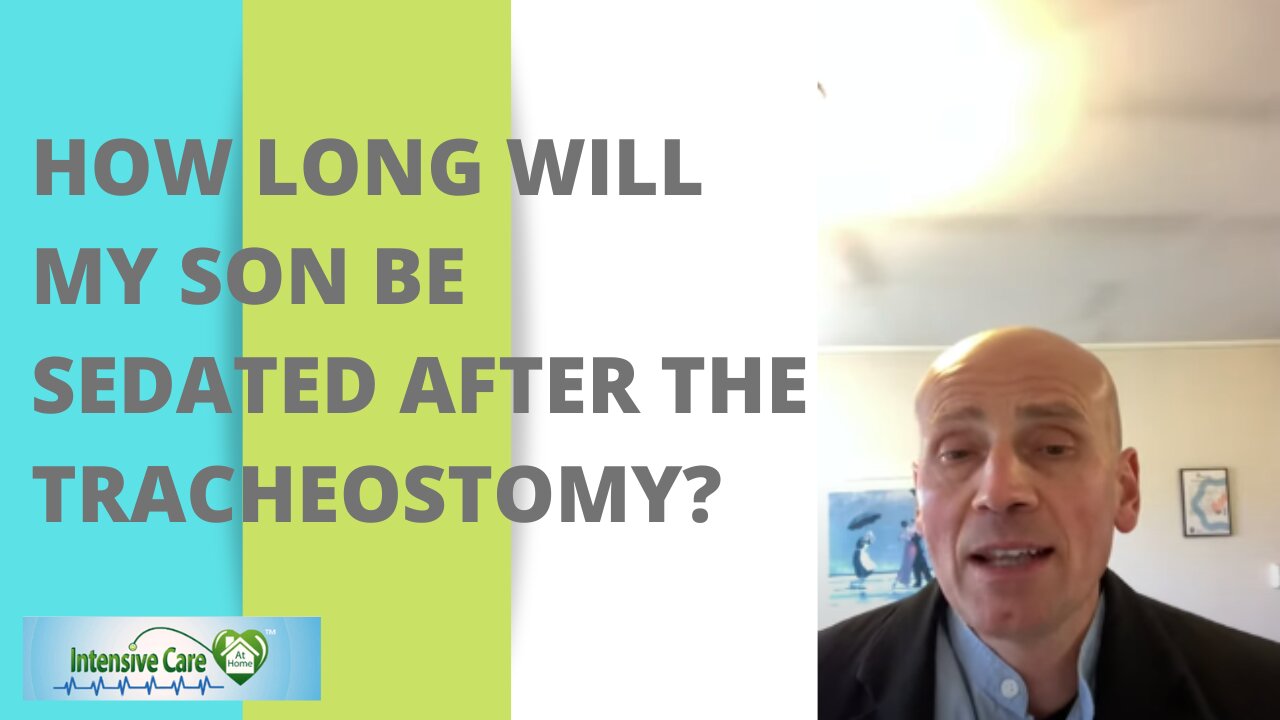Premium Only Content

HOW LONG WILL MY SON BE SEDATED AFTER THE TRACHEOSTOMY?
https://intensivecareathome.com/how-long-will-my-son-be-sedated-after-the-tracheostomy/
HOW LONG WILL MY SON BE SEDATED AFTER THE TRACHEOSTOMY?
Book your free 15 minute phone consultation here
http://intensivecarehotline.com/scheduling-appointment/
Call directly 24/7
+1 415-915-0090 USA/Canada
+44 118 324 3018 UK
+6141 094 2230 Australia
Email support@intensivecarehotline.com
Get 1:1 consulting and advocacy
1:1 phone counselling
http://intensivecarehotline.com/one-on-one-counselling/
Become a member for families of critically ill Patients in Intensive Care
https://intensivecarehotline.com/intensivecaresupport-org-membership/
Immediate action steps http://intensivecarehotline.com/take-control-take-charge/immediate-action-steps/
https://intensivecareathome.com
And if you need a medical record review , click on the link and we can help you with reviewing your loved one’s medical records while they’re in ICU.
https://intensivecarehotline.thrivecart.com/review-of-medical-records/
So today’s question is from a reader who asks, how long is a patient going to be sedated after tracheostomy in ICU? And another reason the reader has given me some context is, he said that, his 20-year old son has cerebral palsy and he’s now at the point where he needs a tracheostomy and he wants to know, how long will his son be sedated after the tracheostomy?
Now, it really depends. But the goal of a tracheostomy in ICU is always to minimize sedation. So therefore, as soon as the tracheostomy is done, you should be able to stop sedation. Because ventilation with a breathing tube or an endotracheal tube is very uncomfortable. Therefore, it’s one of the main reasons why someone needs to go into an induced coma, and you want to minimize the time spent in an induced coma. You want to minimize the time spent being on addictive drugs, such as morphine, fentanyl, midazolam, or propofol.
Propofol is not addictive, but midazolam and certainly morphine and fentanyl are. So you want to minimize the time spent on chemical restraints, if you will.
And furthermore, especially when it comes to patients with cerebral palsy, motor neuron disease, spinal injuries, any neuro degenerative conditions that need ventilation, you absolutely should minimize the time spent in the induced coma and on sedation because you want to get back home as quickly as possible. And, especially in your son’s case with cerebral palsy, he should be able to go home as quickly as possible with our service Intensive Care at Home. Because that’s a safe way to get your son home.
You told me he’s also ventilated, he’s on BIPAP ventilation. He now needs a tracheostomy. So, you should be able to go home from ICU as quickly as possible with the ventilator as well. So the only way to really make that transition possible is with 24-hour intensive care nurses and 24-hour intensive care nursing. Because you need to make sure that the airway is stable, that you’ve got someone competent managing an unstable airway, which is what a tracheostomy is.
And that’s according to the evidence-based home mechanical ventilation guidelines. That clearly provide the evidence that the transition from intensive care to home, on a ventilator with the tracheostomy, can only be done with 24-hour intensive care nursing at home.
Now, I know that you are in Australia and you should be getting NDIS (National Disability Insurance Scheme) funding for our service. The NDIS is funding, home care nursing for nurses, for patients on ventilation with tracheostomy. And you should be checking that out. You should be contacting us. If you have any questions about the NDIS and how to obtain funding there.
I really hope that answers your question.
And if you have a loved one in intensive care, you should be contacting us as well here at intensivecareathome.com. Call us on one of the numbers on the top of our website, or send us an email to info@intensivecareathome.com.
Also have a look at our case studies because there, we highlight more about what we can do for our clients, how clients can live at home with ventilation and tracheostomies. And you can look at our case studies as well.
Intensive care at home Case studies
And if you are at home already and you need support for your critically loved one, and you have insufficient support or insufficient funding, please contact us as well. We can help you with all of the above.
And if you are an intensive care nurse or a pediatric intensive care nurse with a minimum of two years, ICU or pediatric ICU experience, and you ideally have a critical care certificate, please contact us as well. Check out our career section on our website.
www.intensivecareathome.com/careers
Continuation...
https://intensivecareathome.com/how-long-will-my-son-be-sedated-after-the-tracheostomy/
-
 16:14
16:14
Intensive Care at Home
13 days agoThe NDIS Administrative Review Tribunal Decides in Favour of Complex Clients to Fund Nursing Care!
11 -
 1:37:05
1:37:05
AlaskanBallistics
8 hours ago $1.98 earnedI Love This Gun PodCast #16
32.8K3 -
 2:59:26
2:59:26
Twins Pod
17 hours agoEMERGENCY PODCAST WITH ANDREW TATE! - Twins Pod - Special Episode - Andrew Tate
175K177 -
 2:52:01
2:52:01
Jewels Jones Live ®
2 days agoTRUMP SECURES BORDER | A Political Rendezvous - Ep. 113
91K36 -
 25:02
25:02
marcushouse
1 day ago $45.91 earnedStarship Just Exploded 💥 What Went Wrong This Time?!
182K84 -
 12:00
12:00
Silver Dragons
1 day agoBullion Dealer Reveals Best Silver to Buy With $1,000
115K11 -
 12:58
12:58
NinjaGamblers
20 hours ago $15.91 earnedIs This The BEST Way to Win At Roulette? 😲
152K13 -
 1:01:54
1:01:54
CharLee Simons Presents Do Not Talk
3 days agoCALIFORNIA'S DONE!
103K43 -
 7:33
7:33
MudandMunitions
1 day agoUnboxing My FIRST Revolver! Smith & Wesson 442 .38 Special and What’s Coming Next for the Channel
130K16 -
 1:01:05
1:01:05
Trumpet Daily
1 day ago $14.12 earnedGermany Started Two World Wars and Now Wants Nuclear Weapons - Trumpet Daily | Mar. 7, 2025
103K92